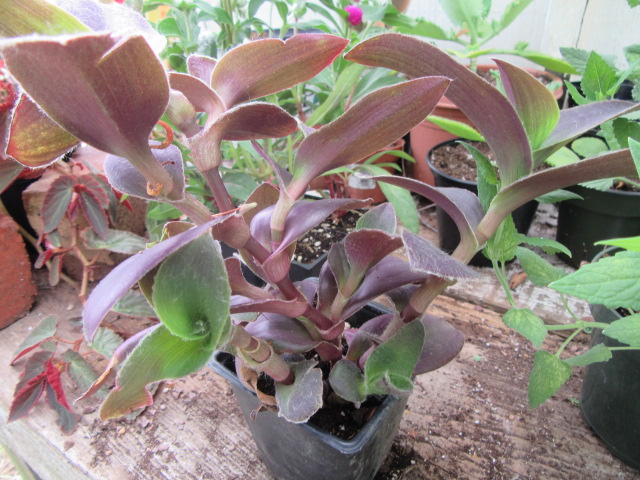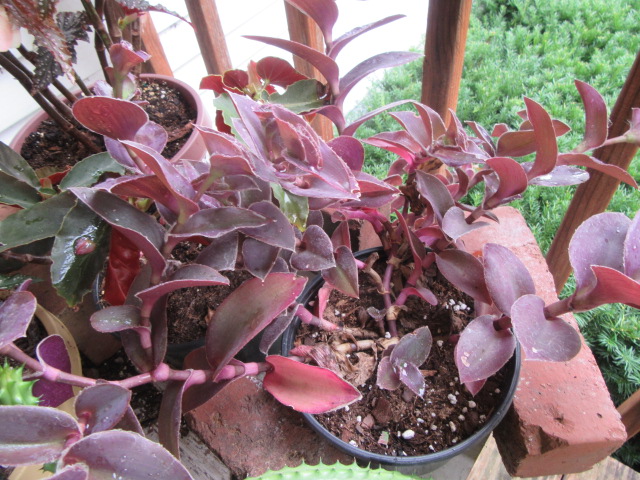
Tradescantia ‘Pale Puma’ from Walley Morse on 10-27-12, #125-15.
Wandering Jew ‘Pale Puma, Purple Heart, Purple Queen
Tradescantia ‘Pale Puma’
Tradescantia pallida x Tradescantia sillamontana
trad-es-KAN-tee-ah
Tradescantia pallida (Rose) D.R.Hunt is the accepted scientific name for the Purple Heart and is likely one of the parents of ‘Pale Puma’. It was named and described as such by David Richard Hunt in Kew Bulletin in 1975. It was first named Setcreasea pallida by Joseph Nelson Rose in Contributions from the United States National Herbarium (Smithsonian Institution) in 1911. Many websites still use this synonym.
Tradescantia sillamontana Matuda is the accepted scientific name for this species and is likely the other parent of ‘Pale Puma’. It was named and described as such by Eizi Matuda in Boletín de la Sociedad Botánica de México in 1955.
The genus, Tradescantia Ruppius ex L., was named by Heinrich Bernhard Ruppius but later described by Carl von Linnaeus in Species Plantarum in 1753. Some of Mr. Ruppius’s writings were published after his death by Albrecht von Haller and Carl von Linnaeus. The genus Ruppia was named after him.
As of 12-13-23 when this page was last updated, Plants of the World Online lists 86 accepted species in the Tradescantia genus. Tradescantia is a member of the plant family Commelinaceae with 36 genera. Those numbers could change as updates are made on POWO.
THERE ARE SEVERAL LINKS AT THE BOTTOM OF THE PAGE FOR FURTHER READING.

Tradescantia ‘Pale Puma’ leaves on 10-27-12, #125-14.
One day in 2012 while living at the mansion in Mississippi, a good friend and fellow plant collector, Walley Morse, brought me this plant. He said it was a Purple Heart but it was different than the Purple Heart I already had which was very common. The other one was given to me by another good friend, Kyle Hall, as a cutting in 2010. The plant Walley gave me had shorter leaves that were kind of fuzzy.

Tradescantia ‘Pale Puma’ on 2-17-13, #139-55.
As temperatures started getting cooler, I moved the Purple Heart Walley gave me to one of the sunrooms along with the other plants. As you can see by the above photo, it became very hairy and changed color with lower light levels.
USEFUL INFORMATION:
Family: Commelinaceae.
Origin: The species is a native of Mexico.
Zones: USDA Zones 8a-11 (10 to 40° F).
Size: 12-18” tall.
Light: Sun to part shade.
Soil: Average, well-draining.
Water: Average. Drought tolerant.
I always grow my Tradescantia ‘Pale Puma’ in light to part shade.
<<<<2013>>>>

Tradescantia ‘Pale Puma’ on 6-1-13, #151-70.
After I sold the mansion in Mississippi, dad asked me to move back to the family farm in mid-Missouri. So, in February 2013, I moved back to the farm with a lot of plants. I gave up several hundred pots, most of them to Walley. I kept most of my cactus and succulents, several perennials, the Alocasia, and several other potted plants. I didn’t bring any of the Purple Heart given to me by Kyle because I figured I could easily find more. Well, that wasn’t the case… Luckily, I did bring the Tradescantia ‘Pale Puma’.
The trip to the farm took 8-9 hours and the temperature was in the 30’s (F) all the way. Another good friend of mine, Thomas Hitchcock, helped me move and when we arrived at the farm after 8 PM, we quickly moved the plants to the basement. The next day I took some of the plants upstairs but many remained in the basement for the rest of the winter.
The plant Walley gave me died shortly after but, of course, I didn’t throw it away. To my amazement, it soon came back up. At first, its leaves were green with only a small amount of fuzz. When temperatures warmed up enough, I moved the potted plants outside for the summer

Tradescantia ‘Pale Puma’ on 7-14-13, #162-53.
Next thing I knew the leaves started turning purple just like the other Purple Heart.

Tradescantia ‘Pale Puma’ on 8-23-13, #178-93.
I knew this plant was a Tradescantia species but could never figure out the species. I read several other people’s comments on various forums that had the same question. None of them were answered sufficiently. The only other Tradescantia I could find with hairy heaves was the Tradescantia sillamontana. This plant was definitely not that species. I thought it was perhaps a cross between Tradescantia pallida and Tradescantia sillamontana since it had features of both species.

Tradescantia ‘Pale Puma’ on 9-1-13, #183-6.
The plant continued growing and spreading very nicely.

Tradescantia ‘Pale Puma’ on 10-7-13, #193-82.
The plant did very well behind one of dad’s sheds under an old Chinese Elm. It started out as part shade but as summer progressed it became more light shade. As the beetles ate holes in the leaves of the tree, more light shone through.

Tradescantia pallida ‘Pale Puma’ on 12-7-13, #208-51.
When winter came in 2013, I put a lot of plants in my bedroom including the hairy Purple Heart. This plant is really not suitable for lower light levels and started growing weird.
<<<<2014>>>>

Tradescantia pallida ‘Pale Puma’ on 7-12-14, #231-87.
I gave up most of my plants, including this one, shortly after the above photo was taken. I started collecting again later but some plants just can’t be replaced.
<<<<2018>>>>

Tradescantia ‘Pale Puma’ on 6-7-18, #455-23.
On June 6 while I was plant shopping with my sister and her husband, I ran across several Purple Hearts at the Wildwood Greenhouse. I didn’t pay much attention to it at the time and thought it was like the Tradescantia pallida Kyle Hall had given me in 2010. I noticed the color was paler, but I thought maybe that was because of the light.

Tradescantia ‘Pale Puma’ on 7-6-18, #471-10.
I had a bad Japanese Beetle invasion which turned the partly shady area where the plant tables were to mostly sun. So, on July 4, I moved the longest plant table to the front porch and most of my potted plants. Then, on July 6, I noticed something strange… This plant was NOT like the Tradescantia pallida Kyle gave me. It was like the one from Walley! So, I did a different type of search and just typed in Tradescantia. As I searched the images online, I found one similar. It was from a web page from San Marcos Growers and their plant was called Tradescantia ‘Greenlee’. They didn’t know the name of the plant, so they named it after the man who gave them their start. Later, they found out the same plant listed by Plant Delights Nursery by the name of Tradescantia ‘Pale Puma’. San Marcos this plant was possibly a cross between Tradescantia pallida and Tradescantia sillamontana, as I had suspected. There are other websites, and Dave’s Garden, that call this particular plant ‘Pale Puma’, so I guess I will, too. I am happy that I now have the mystery solved about this plant’s name. I don’t believe ‘Pale Puma’ is a registered cultivar name. It is just a fitting name but you can call it whatever you want. 🙂
I sent an email to Tony Avent of Plant Delights and in his reply, he said the plant was found and named by their friend Scott Odgen. Their website says Scott gave them this plant as an unnamed selection. I guess later they found out he had named it ‘Pale Puma’ and it has been popular in the Florida Panhandle since the 1990’s.

Tradescantia ‘Pale Puma’ on 7-29-18, #487-100.
The Tradescantia ‘Pale Puma’ was looking very good when I took the above photo on July 29 in 2018. It enjoyed the front porch which is on the west side of the house. Two maple trees provide a little shade.

Tradescantia ‘Pale Puma’ on 10-10-18, #519-68.
I had to move the potted plants inside for the winter on October 10 (2018) because an “F” was in the forecast. The Tradescantia ‘Pale Puma’ was looking a bit untamed. 🙂

Tradescantia ‘Pale Puma’ on 10-10-18, #519-69.
If it had been outside a little longer I believe it would have produced flowers…
<<<<2019>>>>

Tradescantia ‘Pale Puma’ on the right and Tradescantia sillamontana on the left on 6-16-19, #591-44.
We made it through the winter and now the plants are enjoying being outside for the summer. The Tradescantia ‘Pale Puma’ in the above photo is on the right and Tradescantia sillamontana is on the left. Both were still green but they will change color with the increased light. Tradescantia sillamontana, one of the parents of ‘Pale Puma’, is known as the White Gossamer Plant and will become very hairy and turn almost white.

Tradescantia ‘Pale Puma’ on 6-22-19, #593-45.
LOOKING GOOD!

Tradescantia ‘Pale Puma’ on 10-11-19, #639-92.
By the time I had to bring the potted plants inside for the winter on October 11 (an “F” was in the forecast), the Tradescantia ‘Pale Puma’ was strutting its colors.

Tradescantia ‘Pale Puma’ on 11-11-19, #648-8.
The Tradescantia ‘Pale Puma’ was still looking great when the above photo was taken on November 11, 2019. It does very well inside when given ample light. By the time temps are warm enough for the plants to go back outside, it will have lost a lot of its leaves and become a bit leggy. All you have to do is give them a little trimming and they will be fine.
I didn’t take many plant photos in 2020 because I was busy with the garden and other things.
<<<<2021>>>>

Tradescantia ‘Pale Puma’ on 8-20-21, #828-8.
The Tradescantia ‘Pale Puma’ survived the summer just find despite a little neglect.
<<<<2023>>>>

Tradescantia ‘Pale Puma’ on 10-25-23, #969-5.
I moved the potted plants inside for the winter in 2023 on October 24th and 25th. There wasn’t a “F” in the forecast for several days, but it would be rainy all week. The Tradescantia ‘Pale Puma’ did great over the summer despite it being very hot and dry.
I will continue adding more photos and information as time goes by.
Many websites list this plant as Tradescantia pallida ‘Pale Puma’, but it is not a cultivar of the species. It is likely a hybrid between Tradescantia pallida and T. sillamontana therefore NOT a cultivar of Tradescantia pallida. I previously had it named as such but I was in error. Some of the links below may list it as Tradescantia pallida ‘Pale Puma’.
I hope you enjoyed this page and maybe found it useful. If you have any comments, questions, or suggestions, I would like to hear from you. Please click on “like” if you visited this page. It helps us bloggers stay motivated. 🙂 You can check out the links below for further reading. The links take you directly to the genus and species of this plant. If you notice I made an error, please let me know.
A work horse in my gardens, where I offer it to the full sun. Tis also mildly “hardy” here (Border of Zones 6/7.) Most years it returns from fallen stems which rooted and overwintered!!
LikeLiked by 1 person
Hello, Jesserohde! Glad to hear yours is returning at least most of the time. I haven’t tried it in the flower beds here. To cold for it to overwinter here. Great plants! Take care and thanks for the comment!
LikeLike